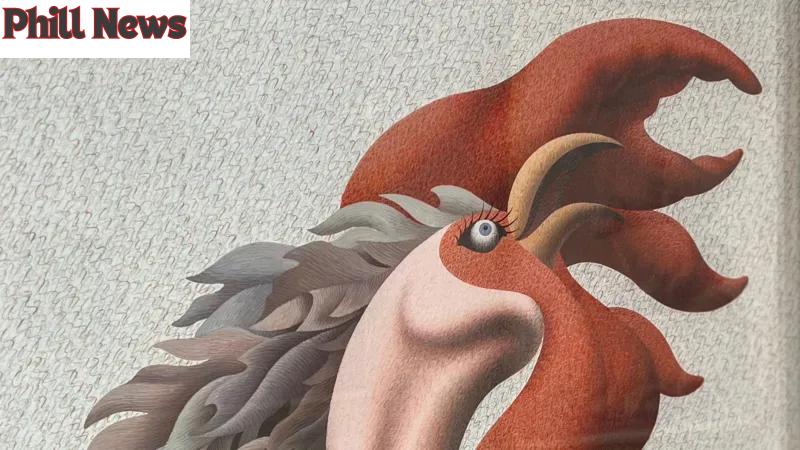
In his younger years, Henry Orlik once had work hung alongside masters such as Salvador Dalí. After more than 40 years away, he has recently come back into the spotlight as a mystery surrounds 78 missing artworks.
For decades the reclusive artist worked from a council flat, where he kept his canvases and paintings stacked or rolled up. But the work of Henry Aulik, 77, who now lives in Swindon, is much smaller than it should be.
Most of it was lost during a stroke hospitalization in 2022 and has never been found.
Without a complete portfolio of his paintings, it is difficult for Aulik to judge the full value of his remaining paintings.
But his dreamy paintings have brought tears to the eyes of art dealers, with one describing him as “one of Britain’s greats”.
“Looking back on a 38-year career in the art world, I think this is truly exceptional,” said Grant Ford at his gallery in Marlborough, Wiltshire.
Ford, who is showing Orlick’s work for the first time since the 1980s, was a specialist at Sotheby’s, the world-famous auction house, for 30 years.

Ford was contacted by a lawyer who wanted to help locate Orlik’s missing 78 paintings, now that he could no longer hold a paintbrush.
He also wanted Ford to view the remaining paintings.
“This is an artist I never knew at all until a few months ago, but he should be considered one of our greats,” Ford said. “I think it’s incredible.”
In the 1970s, some of Orlik’s work was exhibited alongside the likes of Dali, but he became disillusioned with the commercial art world and retreated in the 1980s.
But Ford’s experts couldn’t value Orlik’s work without first selling some of his artwork.
This is where Jan Pietrska, a childhood friend of the family, came to help.

Mr Pietrska explained that Orlik had been evicted from his London council flat while he was in hospital.
The contents have been cleared, but it’s unclear where they went.
To understand what was lost, it’s therefore important to assess what remains.
Orlik is originally of Polish descent and came to the UK with his parents in 1948 and was placed in various resettlement camps before moving to Swindon.
Mr Orlik now lives in his late mother’s house in the city, where he is cared for and can barely speak.
Luckily, he had stored many of his works there over the years.
Pietrska went through a large amount of art and began providing pieces for exhibitions in London and Wiltshire.
“I started to take them apart and then I took them to the Polish Community Centre here because it had a big dance floor,” he explained.
“I photographed them all, numbered them, named them, put them in tubes, and started recording them.”
When Mr Ford brought some of them to London for his first exhibition this year, around 30 works sold for £400,000 (the majority sold before they were even fully on public display), fetching between £5,000 and £40,000 each.

At the second exhibition, held at the Little Gallery in Marlborough, online gamblers bid tens of thousands of pounds. One of the buyers, James Clifford, runs a logistics company by day but is a keen art fan in his spare time.
Having heard about Orlick through his Art Update emails, he raced across London on his moped to the gallery and persuaded them to let him in before the public.
Although he arrived early, he already found “Sea of Red Dots” inscribed on a painting on the first floor of the gallery.
It’s already sold.

“I was blown away because I had only seen the first few pieces. I thought these were some of the most extraordinary pieces I’d ever seen,” he said.
He said he had made an impulse purchase because he wanted one for himself, and he doesn’t regret it at all.
“The skill is some of the best I’ve ever seen from artists,” he said. The first thing that strikes the layman about Orlik’s work is how precise it is. It’s also quite sci-fi-ish.
Ford explained that Orlik has always had a strong interest in physics, and it shows.

He uses little wavy lines on his images that make up the colors, which he calls “suggestions.”
His friend Pietrska said that to achieve this effect, Orlik sometimes uses only a few brush bristles at a time, which can take a lot of time.
Orlik initially trained at Swindon College of Art, a contemporary of Gilbert O’Sullivan and Virgin Atlantic Airways logo designer Ken White, and also attended Cheltenham School of Art.
“He’s a bit of an old guy from Swindon, he’s come from really far away,” he said.
“It’s great to have found these things.”
But for all his skill, dozens of his works disappeared during his stay in hospital.
The hunt is on to find out what happened to them.
 Phill News Entertainment – Phill News
Phill News Entertainment – Phill News